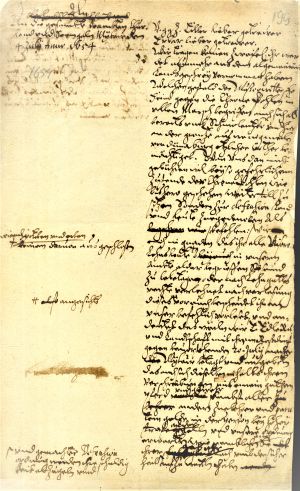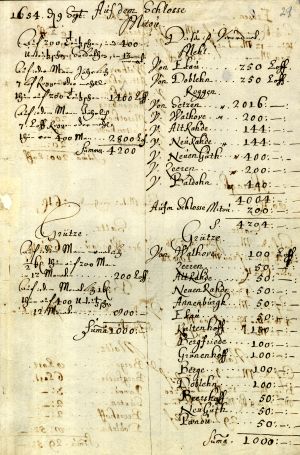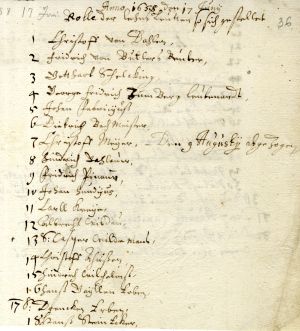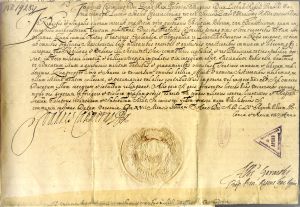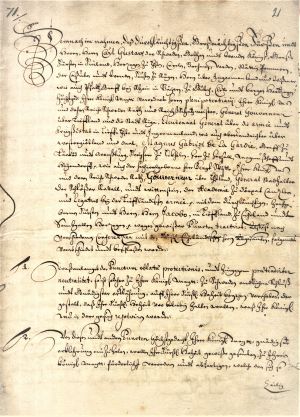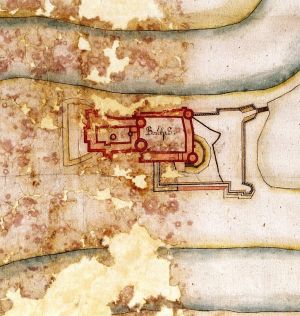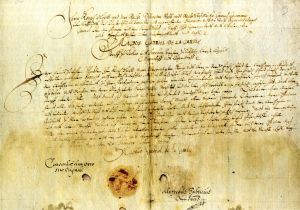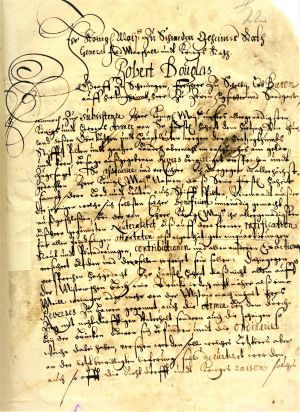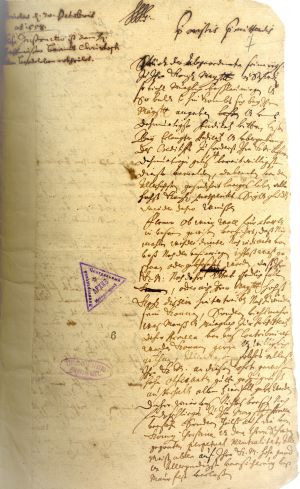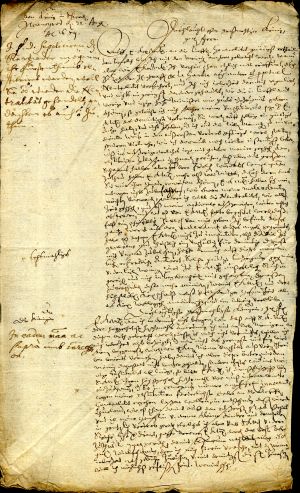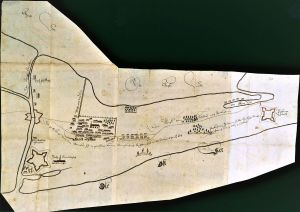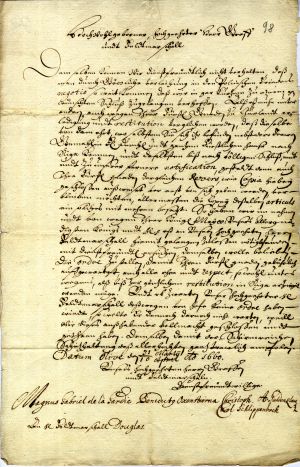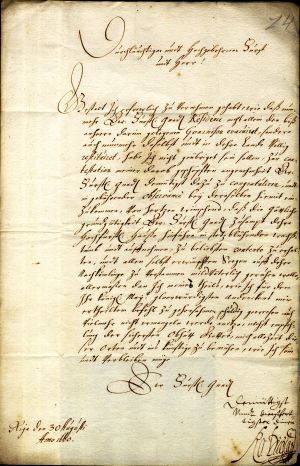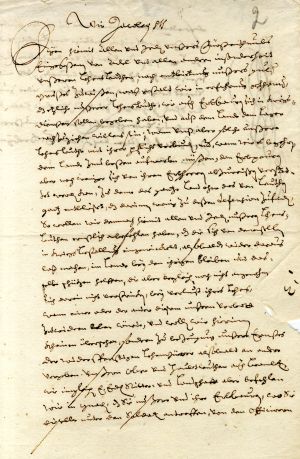In the middle of the 17th century, a series of wars once again commenced not far from the borders of the Duchy of Courland, variously referred to in the historical literature as the First or Second Northern War. Initially, war broke out in 1654 between Poland-Lithuania and Russia; the following year Sweden became involved in a struggle with Poland-Lithuania, and in 1656 a Swedish conflict with Russia also developed. Since Duke James had no real possibility of building a strong army, a policy of neutrality, begun already by James’s uncle, Duke Frederick, was maintained as the best means of defence. Exploiting the various interests of the warring sides, during the first months of the war James was able to preserve the status of the duchy, in spite of Swedish and Russian demands for the annexation of Courland or at least formal submission. It was also convenient for the major powers to use the territory of Courland as a diplomatic channel for envoys from various countries to go to Europe, often meeting in Mitau/Jelgava. The Courlanders were also forced to allow Polish, Lithuanian and Swedish military units to pass through the duchy freely, and had to make large payments in money and in kind. James’s policy of manoeuvring between the warring parties was successful until October 1658, when the Swedes treacherously attacked Mitau/Jelgava and captured the duke. Right up to the beginning of 1660, the territory of the duchy became a battlefield, where the forces of Courland, Brandenburg and Lithuania fought the Swedes. And even after peace was concluded between Poland-Lithuania and Sweden, in spring 1660, the duchy suffered Lithuanian and Russian incursions and plundering. Relative peace was restored only after the Russians left Polish Livonia (Inflanty, Latgale) following the truce between Russia and Poland-Lithuania, concluded at Andrusovo in 1667.
1. Instruction from Duke James to the officials of the duchy. Mitau/Jelgava, 4 July 1654. Draft. LVVA, collection 554, inventory 3, file 521, p. 199.
Since war between Russia and Poland had broken out in June 1654 and the forces of Muscovy were approaching the duchy’s borders, the duke ordered his officials to request all of his vassals to turn up in full military gear for an inspection in Jelgava, planned for 20 July.
Along with other vassals of the duke, free Latvian peasants also had to come to Mitau/Jelgava.
2. Calculation for provisioning the garrison of Mitau/Jelgava Castle. 9 September 1654. LVVA, collection 554, inventory 3, file 60, p. 29.
In an emergency situation, the duke planned to station 200 German and 400 non-German (i.e. Latvian) soldiers in Mitau/Jelgava Castle. They were to be supplied with 4200 Lof of rye, 1000 Lof of groats, 200 Lof of peas, 80 barrels of herring, 200 barrels of meat, 62½ barrels of salt, 37 barrels of butter, as well as two barrels of beer per day. This quantity of produce was to be supplied from the duke’s estates.
Similar plans were made for Bauske/Bauska Castle, where 100 German and 200 non-German soldiers could be stationed. However, even in wartime conditions, the garrisons of the duke’s castles were ordinarily much smaller. For example, in summer 1655, Mitau/Jelgava Castle had one company of German soldiers and three Latvian companies led by German officers, about 400 men in all. Bauske/Bauska had a German garrison of 160 men.
3. Instruction from Duke James to Nicolaus Heinrich von Tiesenhausen, Supreme Captain of Mitau/Jelgava District, and Jacob Jaspers, Commandant of Mitau/Jelgava Castle. Mitau/Jelgava, 22 March 1658. Draft. LVVA, collection 554, inventory 2, file 3200, p. 5.
Because several officers in the Mitau/Jelgava Castle garrison had died, the duke ordered Tiesenhausen and Jaspers to recruit new officers to replace them, adding that it was not essential that they be Courlanders: priority was to be given to experienced and skilled officers, who might also be foreigners.
4. List or roll (Rolle) of vassal cavalrymen who had arrived in Mitau/Jelgava. August 1658. LVVA, collection 554, inventory 3, file 747, p. 36.
The list records 32 vassals who had either personally arrived for military service on 17 and 28 June, and on 7 and 8 August, or had sent someone in their place.
The nobility of the duchy had turned down James’s proposals to replace the vassal army with a force of mercenaries; accordingly, an antiquated system of armed forces continued to exist in Courland, made up of 100 cavalrymen sent by the duke’s estates and 200 sent by the nobles (Rossdienst). In the war years, the diet agreed to pay to maintain a force of infantry for a certain period, but money for this purpose was collected only reluctantly. In an emergency, all the inhabitants of the duchy capable of fighting were supposed to arrive on the field of battle, but most did not have the necessary military skills. Although James retained several companies of soldiers at his own expense and sought to teach the peasants on his estates to use arms, it was clear that the Courlanders would not be able to resist the armies of the major powers. Accordingly, the duke pinned his hopes mainly on Courland’s policy of neutrality.
5. Declaration by King John Casimir of Poland. Warsaw, 17 January 1655. LVVA, collection 554, inventory 1, file 252, p. 12.
In this declaration, John Casimir of Poland confirms the neutrality of the Duchy of Courland in the war between Poland-Lithuania and Russia (1654–1667).
In March 1655, the Russian Tsar Aleksey Mikhaylovich also agreed to the neutrality of Courland. On the other hand, Charles X Gustav refused to confirm the neutrality agreement concluded with James by Queen Christina in 1647 but did give a verbal undertaking not to attack the duchy, so long as James complied with various Swedish demands.
6. Agreement between representatives of the King of Sweden and the Duke of Courland. Pasvalys, 10/20 September 1655. LVVA, collection 4038, inventory 2, file 2175, pp. 2–4.
On the Swedish side, the agreement was concluded by Magnus Gabriel De la Gardie, Governor-General of Swedish Livonia and commander-in-chief of the army, and Bengt Skytte, Governor of Estland, whose signatures appear on the duke’s exemplar of the agreement. Courland was represented in these negotiations by Landhofmeister Friedrich Johann von der Recke and Landmarschall Wilhelm von Rummel. In this agreement, the Swedes promised to spare the duchy, if James did not conclude agreements with Sweden’s enemies. The Courlanders also had to permit the recruitment of soldiers for the Swedish army in Courland and undertook to pay 50,000 thalers, of which sum the duke had already handed over 20,000 thalers. James was to address King Charles X Gustav directly on the matter of the granting of neutrality, sending envoys to the king as soon as possible. In an emergency, the Swedish army was permitted to occupy lodgings in the duchy and station a garrison in Bauske/Bauska Castle. For their part, the Swedes promised to maintain discipline during their army’s marches through Courland and return Bauske/Bauska to the duke once the war was over.
At the same time, an offer was extended to James of submitting to Sweden, to which he answered that he would first have to seek the agreement of the King of Poland.
7. Plan of Bauske/Bauska Castle. First half of 17th century. Swedish Military Archives, Stockholm.
The plan shown here may have been drawn already in the time of the previous Polish–Swedish War (1600–1629), but essentially it reflects the situation as it was in the 1650s. Duke James undertook various repairs to the old castle, but there is no clear evidence concerning transformation of the fortifications.
In summer 1655, the Swedes demanded that James surrender to the protection of the Swedish king and hand over Bauske/Bauska Castle. The duke refused to go over to the Swedish side, but in the Pasvalys agreement he agreed to accept a Swedish garrison in Bauske/Bauska, if this was vitally important to the Swedes. They, in turn, promised to return the castle to the duke after the war. In the years that followed, the Swedes repeatedly tried to force James to fulfil this article of the agreement, but James would not allow it, on the pretext that the military situation was favourable to the Swedes and so they did not need the castle. The Swedes took Bauske/Bauska Castle in October 1658 after capturing the duke. .
8. Guarantee of security (Salvegarde) for the estates of the Duchess of Courland, issued by Magnus Gabriel De la Gardie, commander-in-chief of the Swedish Livonia army. Riga, 20 February 1656. [old style]. Transcript authenticated by Godfried Fabricius, the duke’s senior secretary. LVVA, collection 554, inventory 3, file 763, p. 3.
In this instruction, De la Gardie orders his military commanders not to make camp on the estates of Duchess Louise Charlotte in the course of their marches, not to demand provisions from them and not to inconvenience their residents in any other way.
Such a document was superfluous, because under the Treaty of Pasvalys the duke was forced to agree to the Swedish demand that, when crossing the territory of Courland, its army units had the right to take food from the residents of the duchy, although permission was to be agreed with James in advance.
9. List of plague victims and surviving residents in the town Mitau/Jelgava for the period July–December 1657. LVVA, collection 554, inventory 3, file 2154, pp. 1, 5.
The usual attendants of war in the 17th century were famine and plague, the spread of the latter promoted by the movements of the armies. In 1657, a disease resembling the plague (Pest) spread in Livonia and Courland. In Mitau/Jelgava, 901 people died in the space of 22 weeks, not counting Latvians living at the inns. Mortality was also high in the countryside, especially along the roads used by the armies. Because of the epidemic, in summer 1657, Duke James and his court moved to Goldingen/Kuldīga Castle, where he spent almost a year, making only occasional visits to Mitau/Jelgava.
10. Declaration by Robert Douglas, Swedish field marshal. Headquarters at Bergfried/Svirlauka, 19 September 1658 [old style]. LVVA, collection 554 inventory 1, file 540, p. 22.
Douglas replaced Magnus Gabriel De la Gardie as commander of the Swedish army in Livonia in summer 1658. In this document, he repeats the previous Swedish guarantees of security for the Duchy of Courland, in return for which the Courlanders had undertaken to supply the army with provisions and pay a large sum in cash. James had also promised to build a bridge over the River Kurische-Aa/Lielupe one mile from Mitau/Jelgava to facilitate Swedish troop movements.
At the time he signed the document, Douglas already knew of the king’s intention to arrest James and occupy the duchy, so this was wilful deceit on his part.
11. Plan of the fortifications of Mitau/Jelgava Castle. 1650s. LVVA, collection 6828, inventory 2, file 834.
In the mid-1640s, Duke James modernized the fortifications of Mitau/Jelgava Castle, building five bastions in place of the earlier four (marked A–E). On the south and north sides, so-called hornworks or pincers were created, and a small triangular fortification was constructed in the middle of the curtain wall, on the bank of the Kurische-Aa/Lielupe – a so-called lunette or redan (F). The alterations were completed in the space of three years, with the help of hundreds of peasants, spending a total of 53,271 thalers. The duke wished to recover this sum from the King of Poland, considering it a contribution to the defence of the Polish-Lithuanian state. Moreover, in his notes on the costs, James records that in order to save money, he had not made use of the services of a professional engineer but had instead done the work himself, and had not included in the calculation the economic losses suffered by the duke’s estates because of the absence of the peasants employed in the building work. In the mid-1650s he also surrounded the town of Jelgava with earthworks.
The Swedes took Mitau/Jelgava Castle by cunning on the morning of 10 October 1658 [new style] and captured the duke and his family. Even though Duchess Louise Charlotte had given birth to Prince Alexander only three weeks earlier, on 9 November the duke and his family were taken to Riga, and in August 1659 were placed in the fortress of Ivangorod. The supreme councillors, who formed the duchy’s government, were kept under house arrest in Mitau/Jelgava, and the territory of the duchy once again became a battlefield.
12. Instruction from Duke James to Hofmeister Brandt Christoff von Bardeleben at the court of the King of Sweden. Mitau/Jelgava, 10 October 1658. Draft. First page. LVVA, collection 554, inventory 1, file 537, p. 7.
Bardeleben was instructed to ask the Swedish king to remove the Swedish forces from the duchy or at least release the duke and his family and court from imprisonment and permit them to go to Goldingen/Kuldīga. James promised to stay there until the end of the war as a neutral prince and give up Bauske/Bauska Castle to the Swedes. However, the envoy was to turn down a possible demand for the duchy’s absolute submission to Sweden.
Unfortunately, Bardeleben travelled only as far as Copenhagen, and the duke did not receive his letters, remaining ignorant of the envoy’s fate. In November 1658, the duke and his family were transferred to Riga Castle, and the following year they were taken to the fortress of Ivangorod.
13. Letters from Duke James to Charles X Gustav of Sweden and the Swedish queen. Ivangorod, 22 August 1659. Drafts. LVVA, collection 5759, inventory 2, file 1323, p. 19.
This was the sixth request from Duke James to the king, asking to be liberated from imprisonment and for the duchy to be restored to its previous status. The duke insisted he had not undertaken any acts directed against the Swedes but had been wickedly maligned. James also complained that while he, his wife and children were being kept prisoner, his possessions were suffering great damage. The duke addressed a similar letter to the queen.
14. Letter from Frederick William, Duke of Saxony, to Charles X Gustav, King of Sweden. Altenburg, 13 June 1659. LVVA, collection 1100, inventory 13, file 730, p. 6.
In the letter, Frederick William (Friedrich Wilhelm, 1603–1669), Duke of Saxony, asks the king to free from imprisonment the Duke of Courland and his family, and recommends the duke’s envoy nobleman of Drachenfels, at whose request the Duke of Saxony was writing to Carl Gustav.
A string of rulers of other countries also asked for duke James to be released. These included the electors of Brandenburg, Mainz and Cologne, the dukes of Brunswick-Lüneburg and Brunswick-Kallenberg, the Landgraves of Hesse and even the Holy Roman Emperor. However, the King of Sweden ignored all of their requests.
15. Report from Swedish quartermaster Christ Thumbsen to Robert Douglas. Dobele, 20 May 1659 [old style]. LVVA, collection 554, inventory 3, file 761, p. 62.
The Swedish garrison quartermaster reports that the castle commandant, Major Lindeman, was planning to erect palisades to protect the earthworks outside the castle walls, and that a workforce from the Doblen/Dobele and Autzen/Auce districts was needed to help in this task. Accordingly, he asked for an order to be issued for at least 30 peasants with carts and another 30 on foot to be sent from the surrounding estates for a period of two months.
The Swedes took Doblen/Dobele Castle without a battle three days after they had taken Mitau/Jelgava. In December 1658, Courlander and Polish forces tried unsuccessfully to regain the castle. They succeeded in September 1659, but only for two days. After the enemy had been driven out, Field Marshal Douglas ordered that the defences be ruined as far as possible and the cannon taken to Riga. At that time, the forces of Brandenburg, along with Polish-Lithuanian and Courlander units, were increasingly gaining the upper hand within the territory of the duchy, and the Swedes were short of forces to hold all the castles.
16. Map of the environs of Libau/Liepāja. Dated 7 October 1659. Prussian Secret State Archives, Berlin.
The Swedish forces occupied Libau/Liepāja in early 1659, but in October the town was captured by the forces of the Elector of Brandenburg under the command of Bogusław Radziwiłł, Governor of Prussia. The forces of Brandenburg captured the great fort, which they refused to hand over to the Polish-Lithuanian forces without specific orders from the elector, and, judging from an inscription on the map, they established the small fort of Perkuhnen/Pērkone. After this, Radziwiłł proceeded to Grobin/Grobiņa, where the Swedes surrendered on 19 October, after a siege lasting almost a week.
17. Letter from Johann von der Recke, Landsteward of the duchy, to Duke James in Ivangorod. Mitau/Jelgava, 16 January 1660. LVVA, collection 5759, inventory 2, file 1323, p. 41.
Recke reports that on 10 January 1660 [new style] the Swedish garrison had given up Mitau/Jelgava Castle to the Lithuanian forces led by Alexander Hilary Polubinski, and that now the Swedes only held Bauske/Bauska Castle. He also writes that the duchy has been completely devastated in the war, that the chancellor of the duchy has gone to attend the Polish–Swedish peace talks that have begun at Danzig, and that he himself, together with Barthold von Plettenberg, Supreme Captain of Tuckum/Tukums district, are striving to ensure that the presence of the Polish-Lithuanian forces causes as little damage as possible to the duchy.
18. Letter from the Swedish envoys Magnus Gabriel De la Gardie, Bengt Oxenstierna, Christoph Carl von Schlippenbach and Andreas Gyldenklaus to Field Marshal Robert Douglas. Oliva, 31 March/10 April 1660. Transcript. LVVA, collection 5759, inventory 2, file 1323, p. 98.
The Polish–Swedish peace talks were held in early 1660 at the monastery of Oliva outside Danzig (present-day Gdansk). In the spring, the Swedes agreed to release James, and the envoys informed the officials in Livonia of this, including the army’s commander-in-chief Douglas. Up until the treaty was concluded, the duke was to stay in Riga. Apart from this, James had to sign a special document in which he had to promise not to undertake any acts hostile to Sweden.
19. Letter from John Casimir, King of Poland, to Duke James. Danzig, 6 April 1660. LVVA, collection 5759, inventory 2, file 1323, p. 60, 61.
The king declares that in the course of peace talks every effort would be made to seek an agreement on the restitution of the duchy and that the duke and his family would soon be released from Swedish imprisonment.
20. Attestation by Simon Grundel-Helmfelt, Governor-General of Ingermanland. Narva, 24 May 1660 [old style]; copy of the undertaking by Duke James. Ivangorod, 3 June 1660 [new style]. LVVA, collection 5759, inventory 2, file 1323, p. 64.
The Peace of Oliva was concluded on 23 April/3 May 1660, but another month passed before the Swedes finally released Duke James. In this document, Grundel-Helmfelt testifies that James has signed the undertaking from Oliva before his departure, and that the original remains in Helmfelts’s hands. He is issuing the attestation and a copy of the undertaking to Duke James.
Three weeks after signing the undertaking, James and his family arrived in Riga, and on 8 July they returned to the duchy. Initially, he had to live in Grobin/Grobiņa Castle, because Colonel Egidius de Bremer, commander of the Lithuanian garrison in Mitau/Jelgava, refused to leave it, on the pretext that he had been expressly prohibited from giving up the castle without special permission from the generality of the Lithuanian army.
21. Promissory note signed by Landmarschall Wilhelm von Rummel, with Christoph Grodthaus, Nicolaus von Brunnau and Jost Johann Schulte (Schulltte) as witnesses. Bauske/Bauska, 17 July 1660. LVVA, collection 1100, inventory 13, file 730, p. 16.
In this document, the representatives of the Duchy of Courland promised to pay 10,000 florins to Krzysztof Zygmunt Pac, Chancellor of the Grand Duchy of Lithuania, in gratitude for returning Bauske/Bauska Castle. The chancellor or a person authorized by him was to receive the money in Jelgava eight days before Christmas.
The Swedes had held Bauske/Bauska Castle until the spring of 1660. After the peace had been signed, there were long negotiations between the Swedes, the Courlanders and the Lithuanians as to when the Swedes should leave Bauske/Bauska and which side should then take over the castle. In July 1660, the Swedish garrison finally left Bauske/Bauska, and the Courlanders managed, with great difficulty, to get the Lithuanians to agree to hand over the castle to the duke, promising a sum of money in return. Pac did receive the money, and the promissory note was duly given back.
22. Letter from Robert Douglas, Field Marshal of Sweden, to Duke James. Riga, 30 August 1660 [old style]. LVVA, collection 5759, inventory 2, file 1323, p. 14.
After the war ended, Douglas was very friendly towards the duke. In the letter he congratulates James on the abandonment of Mitau/Jelgava Castle, a few days ago, by the Polish-Lithuanian garrison and its transfer to the duke. He also apologises for having captured James and occupied the duchy, claiming that he had simply been fulfilling the king’s orders and had not wished the duke ill.
James’s negotiations with the Polish-Lithuanian Colonel De Bremer had lasted up to 27 August [new style], when they were taken over by Landhofmeister Recke and by Tiesenhausen, the Supreme Captain of Mitau/Jelgava. James, living in Grobin/Grobiņa at this time, occasionally visited his residence, which had suffered badly in the war, but the duke and his court moved permanently to Mitau/Jelgava only in November 1661.
23. Promissory note signed by Landhofmeister Friedrich Johann von der Recke, Chancellor Melchior von Folckersamb and Landmarschall Wilhelm von Rummel. Copy. Libau/Liepāja, 28 June 1660. LVVA, collection 554, inventory 3, file 228, p. 9.
With this document, the supreme councillors of the duchy attest that they have borrowed the sum of 900 florins from Christophor Loht and 719 florins from Johann Seiller in order to pay money promised to the Brandenburg Colonel Georg von Schoeneich.
The forces of the Elector of Brandenburg remained in Courland until July 1660, and the residents of the duchy had to pay for their maintenance as well as for their withdrawal.
24. Instruction from Duke James to the residents of the duchy. Grobin/Grobiņa, 16 August 1660. Draft. LVVA, collection 554, inventory 3, file 760, pp. l, 2.
Because the land had been ravaged and there was a huge population shortage, the duke ordered the return of all the vassals and serfs who had joined foreign armies during the war. James threatened that vassals who did not comply with the instruction would lose the rights to their fief, their estates being given to others to manage. Peasants found among the soldiers were to be returned to their farmsteads immediately, and if they resisted, they were to receive harsh corporal punishment.
The documents show that during the war both the Swedish and the Polish-Lithuanian forces had been supported by peasants. However, labour was urgently needed to rebuild the economy.
25. Instruction from Duke James. Mitau/Jelgava, 28 December 1661. LVVA, collection 554, inventory 3, file 747, p. 100.
In this instruction the duke reminds the nobility that, in accordance with decisions by the diet, they were to send riders from their fief to assist the persons charged with collecting money from non-payers of the contribution. James urged that they themselves should collect the money, because if the Poles were to start doing it, then the consequences could be even worse.
This order from the duke had to do with the need to collect money that the Lithuanian generals had demanded for their assistance in the war against the Swedes and for their support in the war against the Russians. The total sum to be paid was almost 100,000 florins, or 33,000 thalers. Contribution payments and the supply of provisions to the Polish-Lithuanian army by the Duchy of Courland continued right up to the end of the Polish–Swedish War, in 1667.
